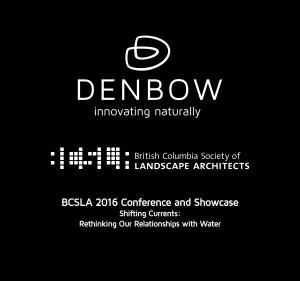A History of Green Roofs – From Vikings to Urban Dwellers
/0 Comments/in Blower Truck Services, Construction Landscape Journal, Environment, Erosion Control, Green Infrastructure, Grinding, Landscape, Landscape Journal, Landscape Mulch, Landscape Supply, Manufacturing, Municipal and Infrastructure Journal, Sediment Control, Slope Stabilization, Soil, Spring Landscape Ideas, Stormwater Management, Streambank Restoration, Sustainable Development, Winter Landscape Ideas /by Tanya RichardsThe Best Methods for Streambank Restorations
/0 Comments/in Biofilters, Environment, Erosion Control, Sediment Control, Slope Stabilization, Streambank Restoration, Sustainable Development /by Tanya RichardsClayburn Village Project Profile
/0 Comments/in Corporate News, Environment, Projects, Stormwater Management, Streambank Restoration, Sustainable Development /by Tanya RichardsA Guide to Working In and Around A Fish Habitat
/0 Comments/in Construction Landscape Journal, Corporate News, Environment, Municipal and Infrastructure Journal, Sediment Control, Streambank Restoration /by Tanya RichardsRiparian Revegetation
/0 Comments/in Blower Truck Services, Construction Landscape Journal, Environment, Erosion Control, Green Infrastructure, Municipal and Infrastructure Journal, Projects, Streambank Restoration, Sustainable Development /by Tanya RichardsBuildex Vancouver 2017
/0 Comments/in Construction Landscape Journal, Denbow Events, Green Infrastructure, Sediment Control, Slope Stabilization, Stormwater Management, Streambank Restoration, Sustainable Development /by Tanya RichardsSustainable Development & Freshwater Quality in Canadian Rivers
/0 Comments/in Construction Landscape Journal, Environment, Sediment Control, Slope Stabilization, Streambank Restoration, Sustainable Development /by Tanya RichardsIn our quest for sustainable development, a major consideration must be maintaining the water quality of our streams, rivers and other water sources. These water sources support plant and animal habitats, as well as human commercial, industrial and recreational activities.
The following article on freshwater quality trends in Canadian rivers was originally posted on the Environment Canada website but has been reproduced below for your convenience. As mentioned below, a key factor affecting the quality of water in Canadian rivers is the amount of rain and snowfall during the year, which can carry soil and pollution through runoff and leaching into the rivers. The way that construction development is performed greatly affects the sustainability of our rivers for the long term.
As the article concludes, one important factor in reversing water quality trends in our rivers is to build the health of stream banks by planting native vegetation and trees. Another important part of ensuring the long-term establishment of this vegetation is to rejuvenate and stabilize the soil with compost-based soils and growing mediums, as with Denbow’s Terraseeding service.
Freshwater Quality in Canadian Rivers
The Freshwater Quality in Canadian Rivers indicator is designed to provide an overall measure of the ability of select rivers across Canada to support aquatic life.[1] It integrates multiple pressures from human activity upstream of water quality monitoring sites to present freshwater quality in the regions where the majority of Canadians live.[2]The indicator focuses on rivers with higher risks to water quality and provides Canadians with an indication of human impacts on freshwater quality.
For the 2010 to 2012 period, freshwater quality in Canadian rivers where human activities are most concentrated was rated:
- excellent or good at 45% of monitoring sites,
- fair at 37% of sites,
- marginal at 16% of sites, and
- poor at 2% of sites.
Overall, freshwater quality in Canadian rivers can maintain healthy river ecosystems.
National freshwater quality indicator, Canada, 2010 to 2012 period
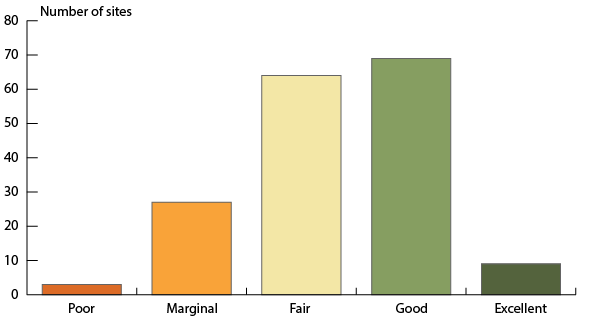
The bar graph presents freshwater quality rating in rivers selected to be representative of the regions of Canada where human activities are most concentrated for the period 2010 to 2012. The bars show the number of sites where freshwater quality was rated excellent (9), good (69), fair (64), marginal (27) and poor (3). Ratings are based on data from 172 monitoring sites.
Note: Freshwater quality was assessed at 172 sites on select rivers throughout 16 of Canada’s drainage regions where human activity is most intensive using the Canadian Council of Ministers of the Environment’s Water Quality Index.
Source: Data assembled by Environment Canada from federal, provincial, territorial and joint water quality monitoring programs.
Clean freshwater is an essential resource. It provides habitat for aquatic plants and animals, supports many commercial and industrial uses, and is at the heart of many recreational activities. Impaired water quality can undermine both aquatic ecosystem health and economic activities, such as fisheries, tourism and agriculture.
Freshwater quality varies naturally across Canada because of the country’s diverse geology and climate. It is further shaped by the ways in which people have developed the land around rivers and lakes. Each freshwater quality monitoring site has its own unique geography and set of human pressures.[3]
The rivers included in the indicators are selected to be representative of the drainage regions in Canada where human activities, such as industry, agriculture, urban growth and recreation, are most concentrated. The potential impacts of these human activities mean that these rivers are generally considered to have a higher potential for water quality impairment. At each site, physical properties of water, such as temperature, and levels of chemical substances, such as nutrients and metals, are measured and compared to freshwater quality guidelines. The more often a freshwater quality measurement is above its guidelines, the lower the freshwater quality rating will be.
Change in the national freshwater quality indicator through time
Between 2003–2005 and 2010–2012, there was an increase in the percentage of sites rated good or excellent and a decline in the percentage of sites rated poor or marginal.
Overall, the freshwater quality scores have:
- improved at 11 sites;
- declined at 4 sites; and
- showed no change at the remaining 85 sites.
National freshwater quality indicator, Canada, change between 2003–2005 and 2010–2012
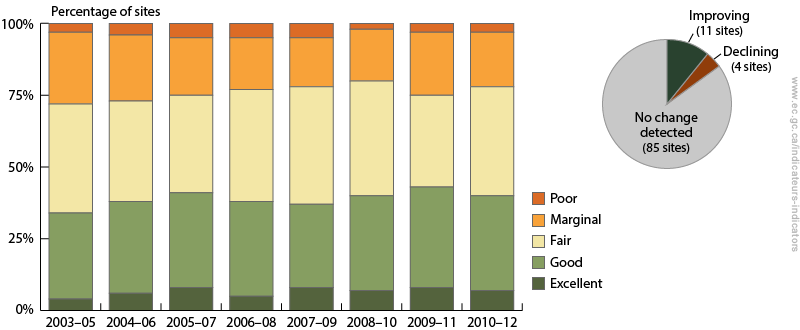
The bar graph shows the percentage of sites where freshwater quality was rated excellent, good, fair, marginal and poor between 2003–2005 and 2010–2012. The inset pie chart shows the number of sites where the freshwater quality indicator has improved, where it has deteriorated, and where no change was detected. Between 2003–2005 and 2010–2012, the freshwater quality indicator rankings have improved at 11 sites and declined at four sites. No change was detected at 85 sites.
Note: Change in the indicator between the 2003–2005 and 2010–2012 periods was assessed at 100 sites in 16 drainage regions across Canada where historical data are available. For each site, change in the indicator was assessed using a consistent set of water quality guidelines and parameters through time.
Source: Data assembled by Environment Canada from federal, provincial, territorial and joint water quality monitoring programs.
Freshwater quality is affected by rain and snow which controls how much water runs off the land or leaches through soils. It is also affected by pollution released directly into it or that travels across land and through the air. Urban growth, agricultural practices and industrial development impact how water moves across the land and change water quality along the way. These multiple pressures on water quality mean freshwater quality trends are slow to change.
The decline in water quality can be reversed by upgrading wastewater treatment plants, adopting environmental farming practices, or planting native vegetation, such as trees, along rivers.
Save
Erosion Control on Steep Slopes and Embankments
/6 Comments/in Environment, Erosion Control, Municipal and Infrastructure Journal, Sediment Control, Streambank Restoration, Water Abatement /by Tanya RichardsErosion Control
As land development happens in hilly countryside, more erosion control on steep slopes and embankments is needed. Especially in areas that experience heavy rainfall. Steep slopes and embankments that have no vegetation or cover are especially vulnerable to erosion issues. Erosion can cause damage to not only the landscape, but any infrastructure surrounding the project. It is important to protect the hillside from erosion during and after the project is complete.
Erosion is basically the displacement of soil from one area to another. On steep slopes and embankments erosion is caused primarily by water, especially by heavy rainfall. Rain that falls onto the exposed ground dislodges soil particles which are then carried away down the slope by the flowing water. However, it is the resulting destabilization of slope that creates an even greater danger as rocks and trees roots become exposed.
There are several ways of controlling erosion on steep slopes and embankments.
 Natural Solutions
Natural Solutions
The most effective, natural way to control soil erosion on steep slopes and embankments is to plant vegetation. Not only will the grass, fescue and leaves help to slow down raindrops as they fall, the roots of the plants will also help to hold the soil together, making it harder for water to wash it away.
However, when planting vegetation on a slope to stop erosion, you need to keep in mind that what you’re planting is just as important as the planting. Though grasses can create a groundcover that can absorb some moisture, they have less effective storm water filtration ability compared to native ground cover. Various typical erosion control seed specifications are available as well as custom seed blends to mimic the native grasses in the area.
Artificial Solutions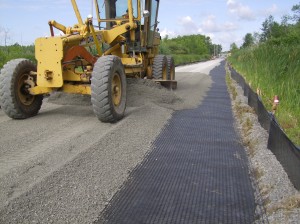
Other than planting vegetation, there are also a variety of artificial solutions you can use. For instance, the use of geomats has become popular over the last few years. Geomats are water permeable polymers that are used to help fix soil elements, grass and small plant roots, and have been shown to work extremely well, especially on barren slopes that have no vegetation. There are even biodegradable geomats that are now being produced that are designed to prevent erosion and give freshly planted vegetation a chance to grow.
Building Terraces
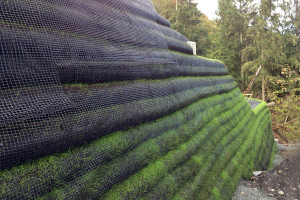 Building terraces is also another way to help prevent soil erosion. When most people think of terraces as a method of erosion control, some may think of the incas in Peru. There the natives implemented the early methods of erosion control on the Andes mountains for many centuries. Terrace walls help to hold soil in place while providing a convenient surface to plant a variety of plants. Building terraces can be as simple as using a couple of wooden blocks to create a terrace wall, or it could be more sophisticated and involve the use of engineered stones, concrete retaining wall blocks or a living green wall solution.
Building terraces is also another way to help prevent soil erosion. When most people think of terraces as a method of erosion control, some may think of the incas in Peru. There the natives implemented the early methods of erosion control on the Andes mountains for many centuries. Terrace walls help to hold soil in place while providing a convenient surface to plant a variety of plants. Building terraces can be as simple as using a couple of wooden blocks to create a terrace wall, or it could be more sophisticated and involve the use of engineered stones, concrete retaining wall blocks or a living green wall solution.
Soil Composition Enhancement
You could also control erosion by controlling the soil itself. As heavy rain tends to be the biggest culprit for soil erosion on slopes and embankments, by controlling the composition of the soil, you 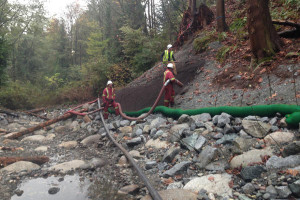 could control the effect that water has on it and therefore the likelihood that it will be eroded. Soil that is high in organic material tends to absorb more water, therefore, using organic material such as compost, aged mulch, or a manure can go a long way in preventing soil erosion.
could control the effect that water has on it and therefore the likelihood that it will be eroded. Soil that is high in organic material tends to absorb more water, therefore, using organic material such as compost, aged mulch, or a manure can go a long way in preventing soil erosion.
The best solution (or multiple solutions) is best determined by evaluating each slope individually.
Save
BCSLA Showcase
/0 Comments/in Announcement, Environment, Erosion Control, Green Infrastructure, Sediment Control, Slope Stabilization, Stormwater Management, Streambank Restoration, Water Abatement /by Tanya RichardsTomorrow and Saturday we’re participating in the BC Society of Landscape Architects (BCSLA) 2016 Annual Conference and Showcase. Landscape Architects, visit us in booth #16 to check out our models of Cascadia Green Wall System and EcoBlanket.
Looking forward to meeting you and focusing on “Shifting Currents: Rethinking our Relationships with Water”.

